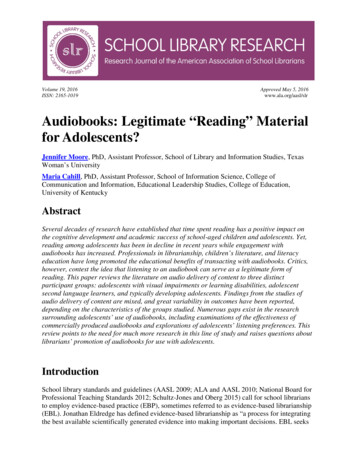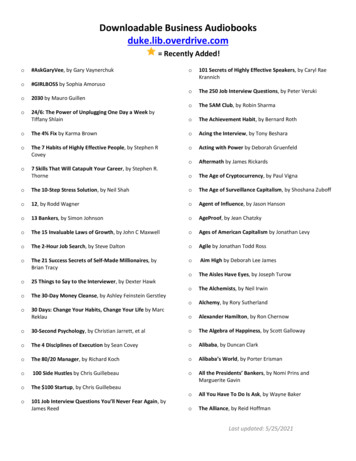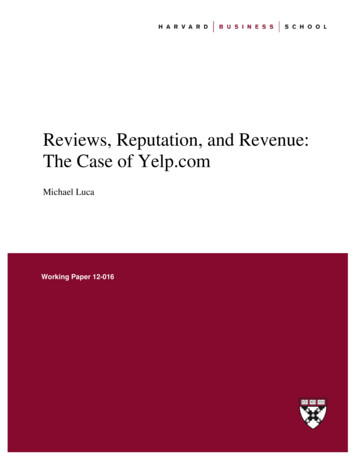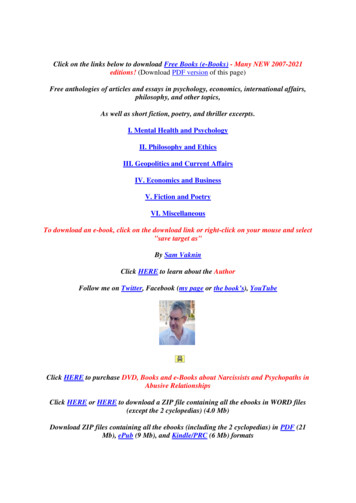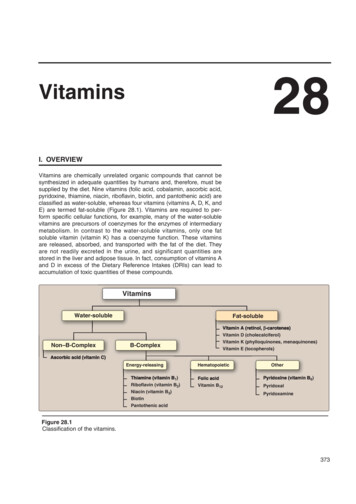
Transcription
Reviews of books and audiobooks in ItalianSusanna Agnelli (1922-2009), Vestivamo alla marinara, 231pp. (1975). SusannaAgnelli’s paternal grandfather founded the Fiat company in 1899. She was thus a memberof one of the richest families in Italy.Vestivamo alla marina is an autobiography beginning in childhood and ending withAgnelli’s marriage in 1945. The title “We dressed like sailors” refers to the sailor-suits herparents made all the children wear, and gives little hint of what the book is really about. Itbegins with the sailor-suits and her upbringing under the stern eye of British nanny “MissParker”, but before long Italy has joined the Axis and the young “Suni”, as Susanna wasknown, is volunteering as a nurse on ships bringing injured soldiers from Africa back to Italy.As a war memoir it is fascinating, including for example an account of the utter confusionand chaos created by the Armistice of September 8, 1943 (Suni was in Rome at the time).Judging by her own account, Suni was a very courageous young woman, but it is only fairto point out that her war experience was highly atypical because of her access to wealth andpower. In the middle of the war, she takes a ski vacation in Switzerland. When she and herbrother Gianni need a car in Firenze, hoping to get to Perugia where they can hide out inone of their grandfather’s numerous houses and await the allied advance, as Agnellis theyhave only to go to the local Fiat headquarters and they’re set. This is not to say that lifewas easy, and indeed the trip to Perugia ends in disaster.Even the richest of women could not escape the extreme sexism of the era. Sometimeafter Suni’s father died in a bizarre seaplane accident, her mother had an affair with writerCurzio Malaparte (whose novel La Pelle will eventually be reviewed here). The grandfatherresponded by cutting her off from the family income and taking away her seven children—allof which was within the law, apparently. However, and here we see again the unusual accessto power, the mother went to Rome and convinced Mussolini to intervene personally. Sunitoo was in a constant battle with sexist attitudes, as a nurse and in her personal life.One glaring omission of the memoir is that it avoids discussing the extent to which theAgnelli family supported the fascist regime. The issue is alluded to occasionally but neverdirectly confronted. But whatever the truth of the matter may be, Vestivamo alla marinaremains a fascinating glimpse of the period through the eyes of the super-rich.Agnelli tells her story in a conversational style, in about eighty two or three-page chapters,which makes it an easy read. Highly recommended.Milena Agus, Mal di Pietre, 119pp (2006), audiobook 2hr 21 min, read by MargheritaBuy. A short novel of three generations of Sardinian women, focusing mainly on the life of“Nonna” as told by her granddaughter. According to the audiobook cover, Mal di Pietre“ha ottenuto uno strepitoso successo di pubblico e di critica, anche all’estero”. I found someaspects of it very interesting (including a creative, unexpected conclusion), and others lessso. The inclusion of the lurid and demeaning details of “le prestazione delle Case Chiuse”,which the reticent Nonna rather improbably offers to her husband, seems calculated to gainan “R” rating, so to speak, just as is often done in the movies. Although I’m not opposedto lurid details on principle, in this instance they detract from an otherwise engaging story.The first time around I only listened to the audiobook, but this is a bit tricky becausethe story constantly jumps around in time. Reading the book at the same time is definitely1
recommended, for the aforementioned reason as well as the fact the book includes someinteresting Sardinian dialect (translated into Italian in the footnotes, which are in turn whatone hears in the audiobook).Sibilla Aleramo (1876-1960), Una donna, 220pp. (1906). Sibilla Aleramo is the penname of Marta Felicina Faccio. Una donna can be regarded as an autobiographical novelwhich, according to the website Sibilla Aleramo.it, very closely follows her real life. Forexample, at age 12 Aleramo’s family moved to Civitanova Marche, on the Adriatic coastsouth of Ancona, where her father managed a glassware factory. In the novel the townis named only as “una cittàduzza di Mezzogiorno”. Aleramo was one of the first Italianfeminists, and for that reason alone it is an interesting, important book. But it is not aneasy read (I found the vocabulary rather difficult) and not a book to read for pleasure.In a sense, it is not so much a novel as a kind of tortured lament and self-analysis, anexcruciatingly painful attempt to come to terms with her decision to leave her husband andson, as well as a feminist manifesto. (In real life, her son Walter was seven when she left,and they did not see each other again for 31 years.) She wanted to take her son with her,but under Italian law at the time a wife was little more than the property of her husband,and she had no rights whatsoever. Indeed only the threat of losing her son kept her fromleaving the marriage years earlier—a marriage that began with her future husband rapingher when she was 15.It is quite amazing that despite being trapped in the ultra-sexist environment of Italy c.1900—trapped both figuratively and literally, as for a long time her husband kept her andthe baby locked in the house—this young woman transformed herself into an independent,creative, feminist thinker. One longs to know more about exactly how her awakening cameabout, but in this respect the book is a disappointment: Aleramo gives very little in the wayof details and examples. In Chapter XII, for example, we find:Pensare, pensare! Come avevo potuto tanto a lungo farne senza? Persone e cose, librie paesaggi, tutto mi suggeriva, ormai riflessioni interminabili. Talune mi soprendevano,talaltre, ingenue, mi facevono sorridere.La loro verità era infinita.But what exactly were these reflections? We don’t know. Earlier in Chapter XI, we read:In quei giorni di infinita solitudine, nel silenzio di ogni richiamo umano, abbandonataveramente ogni speranza e ogni fede, trovai in un libro una causa di salvezza.Now we are dying to know more about this libro, but learn little more than that theauthor was a “giovane sociologo” writing of his “viaggi in paesi giovani” and of the problemsthat arise from cultural differences. Why and how the book was a “causa di salvezza” isexplained only in vague general terms. Some specifics would be far more enlightening. Latershe writes a short article for a journal in Rome, which publishes it. “Era in quello scrittola parola femminismo”, she says, and gives no further details. “Intanto il mio scartafacciocresceva di mole.si svolgeva in cento frammenti il filo delle mie considerazioni sulla vita.”But alas, not a single example, not a frammento, is given of what she wrote.It would have been very interesting to have more detail, and would have made a betternovel as well. But ultimately it is not a novel. Maria Corti said it best, in her preface to the1950 edition:2
Una volta entrata in scena, Sibilla Aleramo rompe tutti i ponti con la piccola vita borgheseche l’attendeva; la stampa di Una donna è la sua dichiarazione di guerra.I highly recommend this “declaration of war”, but don’t expect it to be pleasant.Isabel Allende: A great writer, whose novels translate well from Spanish to Italian(I have this on authority of a native Italian). Ironically, I probably wouldn’t have gottenstarted reading Allende without my interest in Italian.1. L’isola sotto il mare. Audiobook is good too (14 hours 10 minutes). Takes place atthe time of the slave rebellion in Haiti, c. 1800.2. Il quaderno di Maya.3. D’amore e ombre.4. La casa degli Spiriti. Audiobook (17 hours). Her first novel. This one and the previoustwo all involve, sooner or later, the military coup in Chile in 1973. The audiobooks of 1 and 4are both read beautifully by Valentina Carnelutti, who, as it turns out, also plays Francescain one of my all-time favorite movies La Meglio Gioventù (a six-hour miniseries).5. Il mio paese inventato. A memoir on certain aspects of her life (in Chile until themilitary coup, then ten years in Venezuela, divorce, remarriage to an American in SanFrancisco). Much of the emphasis is on Chileans as a people, but there is personal detail aswell. Very interesting.6. La figlia della fortuna. The story begins in Valparaiso, Chile, in the 1830’s. Atthat time British immigrants were well-established in Valparaiso. (When Darwin was inValparaiso during the voyage of the Beagle, he stayed with an old school chum there. Andaccording to Wikipedia, about 4 percent of the current population of Chile is of Britishdescent). Later the action moves to California during the Gold Rush. The main character,Eliza, is an orphan raised by a British siblings Jeremy and Rose Sommers. To avoid spoilers,I’ll say no more; this is one of my favorite Allende novels so far.7. L’amante giapponese, 281pp. (2015). A disappointment; toward the end I justskimmed. The basic set-up is promising, but it didn’t work for me. Also, although it isdifficult for a non-native speaker to judge, it seemed to me that it is a poor translation.8. Inés dell’anima mia, 322pp. (2006). For me, the historical context—the Spanishdestruction and enslavement of the indigenous populations of Peru and Chile in the 1500’s—is just too depressing to enjoy the novel, based as it is on a real historical figure. In contrastto “L’isola sotto il mare”, the main characters aren’t engaging enough to make it a goodread.Niccolò Ammaniti:1. Io no ho paura, 219 pp. (2001). Narrated by a 9-year old boy in passato prossimo andimperfetto. Highly recommended. The film is good too.An audiobook came out in 2013, read by Michele Riondino (5hr 42 min). Riondino’sreading is superb, lending even more suspense to an already gripping story.2. Io e Te. 116 pp. Not as good as no. 1, in my opinion.3. Fango. 317 pp. A collection of stories featuring senseless and at times quasipornographic violence, with no redeeming features that I can discern. In particular, I challenge anyone to justify the existence of the revolting Rispetto. Perhaps you could explain3
to me how a graphic tale of the brutal gang rape and murder of three young women can bedesribed as (I quote from the book cover) “una gustosissima vena comica”, “uno scintillantespettacolo”, and “un autentico, irripetibile gioiello”. After Rispetto it is impossible to takeAmmaniti seriously as a writer; he is more like an adolescent boy trying to shock the grownups with the bad words he’s learned. In my case he’s succeeded in this aim; beato lui. Butwhat a waste of talent.Jane Austen, 1. Ragione e sentimento, audiobook 12hrs 38min, read by Paola Cortellesi.Although I’ve never read any of Jane Austen’s novels, I’ve seen almost every movie version,some of them multiple times (Sense and Sensibility being my favorite). As a result I foundthe audiobook interesting even apart from the Italian language aspect, as I was getting thecomplete story for the first time. Entertaining, with a high percentage of dialog, well-readwith some real acting by Cortellesi (her “Signora Jennings”, for instance, is quite amusing).I’m not sure why, but the frequency of subjunctive conjugations in the story is exceptionally high. Constructions of the type “per quanto fosse.” alone occur dozens of times. Soit’s a great way to tune your ear to the subjunctive, in all of its tenses, if you want practicein that. Another small but significant bonus is that the 50 short chapters are all announcedwith ordinal numbers: “capitolo quinto”; “capitolo sesto”, capitolo trentunesimo” etc. Youcould of course memorize these from some grammar book or another, but how much morepleasant to practice the ordinals with the Dashwood sisters!2. Orgoglio e pregiudizio, audiobook 12hrs 23min, again read by Paola Cortellesi. Itwould be easy to ridicule Austen’s novels. An extraterrestrial whose only knowledge ofearthlings came from reading Austen would have to conclude that no one actually works fora living; they only go to dances, go for long walks in the countryside, read, play cards andgossip about how much so-and-so will inherit when his father kicks the bucket. Meanwhilefood, clothing and shelter appear as if by magic. Indeed, it is remarkable the extent towhich Austen does not even acknowledge the existence of those who do actual work—evenmiddle-class work, let alone agriculture and other physical labor. And setting aside the issueof the working classes, one is still left to wonder: Don’t these people ever do anything? Andwhy do they all talk as though they were delivering a paper “Interpersonal relationships inearly 19th century England” at the London Psychological Society?Far be it from me, however, to engage in such ridicule. The fact is that Orgoglio epregiudizio is a lot of fun, and all the more so because of Cortellesi’s creative reading. Herrendition of Mr. Collins is especially amusing, as is her interpretation of Mrs. Bennett.Highly recommended, again with the bonus of much practice in the subjunctive and theordinal numbers.Ippolita Avalli, Mi manchi (audiobook about 8 hours, 2008), read by Alessandra Bedino. The set-up: Single mom Vera and her son 18-year old son Gabriele have a very strainedrelationship. He disappears during a trip to London, and his mother goes to look for him.This part of the plot inches forward at a maddeningly slow pace, continually interrupted byflashbacks to Vera’s earlier life: love interests, abortion, the terrorism of the Brigate Rossein the 70’s. Although I enjoyed much of it, I found the ending to be anti-climactic and trite,including elements reminiscent of a cheap romance novel. The reading by Bedino is excellentthough; definitely worth a listen.4
Honoré de Balzac (1799-1850), Eugénie Grandet, 189pp (1833). In some ways, theplot and style of Eugénie Grandet brings to m
Isabel Allende: A great writer, whose novels translate well from Spanish to Italian (I have this on authority of a native Italian). Ironically, I probably wouldn’t have gotten started reading Allende without my interest in Italian. 1. L’isola sotto il mare. Audiobook is good too (14 hours 10 minutes). Takes place at


